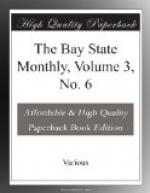Thus ended the greatest charge known to modern warfare. Made in a most unequal manner against a great army and amidst the most terrific cannonade known in wars, and yet so perfect was the discipline, so audacious the valor that had this handful of Virginians been properly supported they would perhaps have rendered the Federal position untenable, and possibly have established the Southern Confederacy. While other battle-fields are upturned by the plough and covered with waving grain, Cemetery Ridge will forever proudly uphold its monuments telling of glory both to the Blue and the Gray, and our children’s children while standing upon its crest will rehearse again of Pickett’s wonderful charge.
* * * * *
THE PATRIOT, SAMUEL ADAMS.
BY EDWARD P. GUILD.
[Illustration: SAMUEL ADAMS. FROM COPLEY’S PAINTING.[1]]
Three years ago the old State House in Boston was restored to its original architectural appearance. After having fallen a prey to the ruthless hand of commerce, been surmounted with a “Mansard roof,” disfigured by a legion of business signs, made a hitching place for scores of telegraph wires, and lastly been threatened with entire demolition by the ever arrogant spirit of “business enterprise”; the sentiment of patriotic veneration asserted itself and came to the rescue. With an appropriation of $35,000 from the city, work was begun in the fall of 1881, and by the following July the ancient building had been restored to almost exactly its appearance in the last century. As the Old State House now stands, it is identical with the Town House which Boston first used for its town meeting May 13, 1713. This was nine years before the birth of the man destined to become the foremost character in the Boston town meeting of the eighteenth century—Samuel Adams. Probably no other man who ever lived has been so identified with the history of the Old State House as was he. The town meetings were held in Faneuil Hall after 1742, but through the stormy years when the Assembly met in the old building, Samuel Adams was in constant attendance as clerk. His desk, on which he wrote the first sentences ever ventured for American independence, and by which he arose, and, with hands often tremulous with nervous energy, directed the exciting debates, is to-day in the old Assembly chamber in the western end of the building. In 1774 he went to Congress, but for a long period afterward the Old State House was again his field of labor, as senator, as lieutenant governor and then as governor.
The life of Samuel Adams ought to be more familiar than it is to the patriotic young men of to-day, but some excuse is found in the fact that a popular, concise biography has, until lately, not been written. The excellent three volume work of Mr. Wells, Adams’ great grandson, although admirable as an exhaustive biography, is too voluminous for the common reader; but since the appearance of Prof. Hosmer’s recent book[2] there can be no reason why any schoolboy should not have a clear idea of the life of the man who organized the Revolution.




